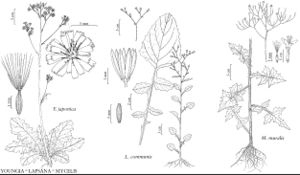Youngia
Ann. Sci. Nat. (Paris) 23: 88. 1831.
| Taxon | Illustrator ⠉ | |
|---|---|---|
 | Youngia japonica Lapsana communis Mycelis muralis | Yevonn Wilson-Ramsey Bee F. Gunn Marjorie C. Leggitt |
Annuals, biennials [perennials], (10–) 20–90+ cm; taprooted. Stems 1–5+, erect (often scapiform), usually branched distally, sometimes throughout, proximally glabrous, puberulent, or tomentose. Leaves all or mostly basal; petiolate (petiole bases often dilated, ± clasping); blades oblong or ovate to oblanceolate, margins usually pinnately lobed (± lyrate), ultimate margins denticulate. Heads (4–150) in corymbiform to paniculiform arrays. Peduncles (filiform) not distally inflated, seldom bracteate. Calyculi of 3–5+, deltate to ovate (membranous) bractlets. Involucres cylindric to campanulate, 2–3+ mm diam. Phyllaries usually 8 in 1–2 series, lanceolate to linear, ± equal (reflexed in fruit), margins ± scarious, apices obtuse to acute. Receptacles flat to convex, ± pitted, glabrous, epaleate. Florets 8–25+; corollas yellow, sometimes abaxially purplish (anther bases with linear, acute auricles). Cypselae ± reddish-brown, ± fusiform and compressed [± terete], weakly or not beaked, ribs 11–13, ± spiculate to scabrellous on ribs; pappi (borne on discs at tips of cypselae) persistent (fragile) [falling], of 40–60+, basally coherent [distinct], white [yellowish or grayish], subequal, smooth to barbellulate bristles in ± 1 series. x = 5 or 8.
Distribution
Introduced; Asia, also in South America, Europe, Africa, Pacific Islands, Australia
Discussion
Species ca. 30 (1 in the flora).
Youngia americana Babcock (based on a specimen from Alaska) has not been used as an accepted name for plants in the flora area; it was treated as a synonym of Crepis nana var. lyratifolia (Turczaninow) Hultén by E. Hultén (1968).
Selected References
Lower Taxa
"fine" is not a number.